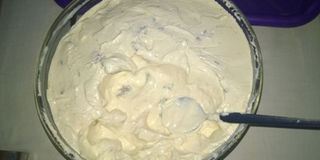Eshabwe, a local delicacy

Eshabwe is a delicacy originally prepared by the Bahima of Ankole and now enjoyed all over Uganda, especially in the Western Region. It is basically a thick white sauce made from salt and mature ghee, and is normally served on important occasions and as a treat.
Eshabwe is easy to make and can be prepared manually or with a blender. The ingredients are very basic – mature ghee and a solution of rock salt and table salt. However, not any old ghee can be used, you must be sure of your source, as eshabwe is made from un-boiled ghee. This is why the ghee must be extremely clean with no traces of any foreign matter whatsoever, such as, specks of dirt, whey or even the remains of the water used to wash it. It must also be prepared using clean utensils and stored in a clean, dry container, until required. In short strict hygiene is paramount!
Ingredients
250g clean, mature ghee
150ml (10 tbsp) warm, previously boiled water
5ml spoon (1 tsp) powdered rock salt
½ tsp table salt
Method
1. Dissolve both the rock and table salt in 75ml (half) the warm water. The water should be warm and not hot.
2. Sieve the solution with two nylon sieves to trap any impurities in the salt.
3. Put the ghee in a small, clean bowl and stir it briskly with a small wooden masher in one direction, until smooth. If you do not have one, use a wooden spoon instead.
4. Add the salt solution, a tablespoonful at a time, stirring briskly after each addition.
5. The ghee should begin to thicken and turn white.
6. Continue adding a little of the salt solution and stirring briskly until the ghee increases in volume, is smooth, thick and pure white.
7. If the ghee curdles (looks like spoilt milk), add a little more salt solution with some of the lukewarm water. All this should be done gradually, a little at a time.
8. When the eshabwe has doubled in volume, is very thick, creamy and pure white, taste a little and add a pinch of table salt if necessary. You may dilute the sauce a little with the remaining lukewarm water but this should be done a tablespoonful at a time, stirring well after each addition. If it is still too thick, dilute further with previously boiled, tepid water, but the final product should be a sauce that is thick and not runny.
9. Sieve with a fine sieve into a clean bowl and serve as a side dish with steaming hot matooke, kalo, cassava, sweet potatoes, a sauce of your choice and greens.
To enrich eshabwe
• Add bite-sized pieces of smoked beef cooked in finely chopped onions and tomatoes and a little water until tender and completely dry.
• Or small pieces of beef boiled in salted water until tender and then stir-fried with finely chopped onions and tomatoes until completely dry.
• Or boil maize cobs in salted water until tender. Drain, remove the kernels and mix with the eshabwe. The kernels should be few, so as not to overwhelm the eshabwe.




